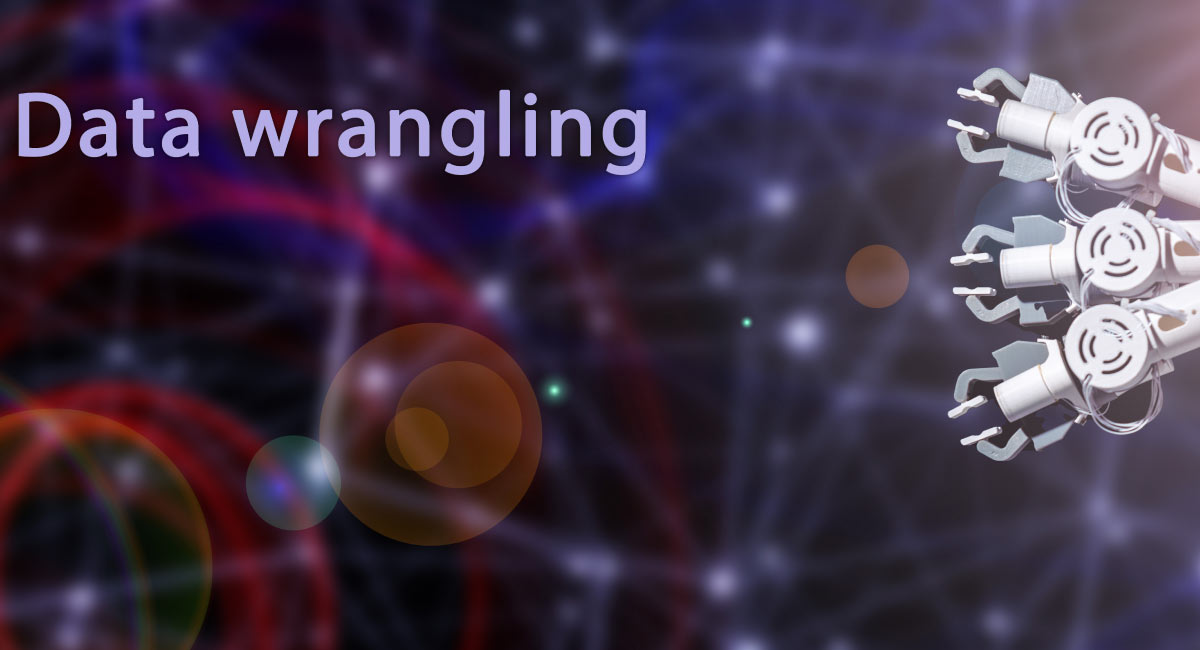People create massive amounts of data daily. However, most of that data isn’t structured in nice, neat packages, ready for data analysts and scientists to use to make informed, actionable decisions. Most of this information is raw, unstructured data. If you want a means to clean it up and help it make sense, you want data wrangling.
Today, we will tackle the question, “What is data wrangling?” We will define the term, break it down into steps, show its importance and benefits, and discuss the tools and skills needed to perform this valuable function successfully. We’ll also share a way for aspiring professionals to get practical training through an online data science program.
So, let’s begin by answering that relevant question: “What is data wrangling?”
What is Data Wrangling?
“Data wrangling” is a term that could conjure up images of cowboys riding on horses, lassoing stampeding groups of letters and numbers. Although the term may come across as silly or odd, pause and consider this: a wrangler, in the world of cowboys, is someone who tames, controls, and handles animals. You need a wrangler to control an animal since animals are often headstrong, unruly, unpredictable, and uncooperative.
Now, consider a data wrangler. Data wrangling is changing raw, messy, complex datasets into formats that make them easier to use in analytics or machine learning processes. Also called data munging, scrubbing, or remediation, it involves reorganizing, mapping, cleaning, and transforming vast quantities of data from its raw form into something that can bring prompt, informed decision-making and better business solutions.
Also Read: Why Use Python for Data Science?
Why is Data Wrangling Important?
Increasingly complex data sets require more time to gather, clean, and organize data before a broader analysis. At the same time, since data informs more business decisions every day, business planners and managers have less time to wait while technical resources prepare vital data, and this is where data wrangling becomes a vital, valuable resource.
This situation requires a self-service model for a more democratized data analysis model. This self-service model, coupled with data-wrangling tools, empowers analysts to tackle more complex data faster, produce more accurate results, and make better decisions. Thanks to data wrangling methods, more organizations have adopted data wrangling tools to prepare their data before attempting analysis.
Here are a few quick points that reinforce data wrangling’s importance:
- It helps improve data usability by changing data into a format compatible with the end system
- It integrates different types of information and their respective sources (e.g., web services, databases, files, etc.)
- It helps quickly build data flows inside an intuitive user interface and allows easy scheduling and automating of the data-flow process
- It helps users efficiently process vast volumes of data and facilitates sharing data-flow techniques
Data Wrangling Steps
The data wrangling process is typically broken down into six steps: explore, transform, cleanse, enrich, validate, and store.
- Explore. Data exploration, also called discovery, identifies patterns, trends, and incomplete or missing information within a dataset. Most data exploration occurs before creating data visualizations, reports, or AI/ML training models, but it’s also typical to find surprises and insights in a dataset during the analysis.
- Cleanse. Data often contains errors due to manual entries, incomplete data, data automatically collected from sensors, or even defective equipment. The data cleansing process corrects these entry errors, removes duplicates, outliers, and missing data, and assigns null values based on conditional or statistical or conditional modeling, improving data quality.
- Transform. Data transformation, or data structuring, is crucial. If it’s not done early, it can negatively impact the rest of the wrangling effort. Data transformation puts raw data in the correct formats and shapes that will be valuable for reports, data visualizations, or an analytic or modeling process. The process may involve creating new variables (e.g., features) and conducting mathematical functions on the data.
- Enrich. Enrichment or blending improves a dataset’s utility by integrating additional sources, such as an authoritative third-party census or demographic and firmographic data. The enrichment process can also help reveal more insights from the organization’s data or inspire new ideas for gathering and storing more customer information in the future. This process presents an excellent opportunity to think strategically about what kinds of additional data might contribute to a model, business report, or business process.
- Validate. Validation rules are repeating programming sequences that verify data quality, consistency, and security. Examples of validation include confirming field accuracy through checks across data (e.g., names or birth dates) or ensuring a uniform distribution of attributes that should be distributed normally.
- Store. The final part of the wrangling process involves storing or preserving the final product and any steps and transformations that occur so it can be audited, comprehended, and repeated in the future.
Some sources consider “Publishing” the sixth and final step. In those cases, publishing the data means placing it in readable formats and sharing it with the appropriate parties so they can use it for analysis purposes. You can make an excellent argument to call the final step “Disposition,” which could mean the data wrangling disposes of the processed data in any way it needs to, whether it’s to be stored or immediately shared.
The bottom line is that these steps and stages are fluid and subject to different interpretations based on the organization’s needs.
Also Read: A Beginner’s Guide to the Data Science Process
The Benefits of Data Wrangling
Data wrangling offers much to data analysts, digital marketers, and business intelligence professionals. For instance:
- It increases clarity and understanding. Anyone who has encountered disorganized data or a large data set that’s difficult to interpret can understand the hassle of not knowing what the data means and what it can be used for. A properly wrangled dataset can more easily be used for reporting with Tableau or other popular data visualization tools.
- It fosters data consistency. Since businesses typically pull data from multiple sources (including third parties), that data can often, unfortunately, include many mistakes. One of the most essential steps in the data wrangling process is building uniform datasets that eliminate human error and different formatting standards across third-party sources. These uniform datasets result in improved accuracy during the analysis process.
- It improves data accuracy and precision. How data is manipulated and formatted can affect the data analysis’s eventual accuracy and precision, especially when identifying significant trends and patterns. Examples of effective data wrangling include organizing data in tables rather than columns or organizing data by numerical data rather than categorical values. When you group similar data, it improves accuracy.
- It improves communication and decision-making. Boosted clarity and improved accuracy shorten the need for others to comprehend and interpret the data, eventually leading to improved understanding and communication between the organization’s disparate teams. This benefit typically increases transparency and collaboration, resulting in better decisions.
- It’s cost-efficient. Organizing data, reducing errors, and fostering collaboration all lead to more efficient use of time, which saves organizations money. For example, thoroughly cleaned and organized data reduces errors, saving developers time creating reports or machine learning models. A consistent dataset makes it easier for data scientists to reuse algorithms in their models or create and apply new ones via data science and automated machine learning.
Data Wrangling Tools
If you want to wrangle data successfully, you need the right tools. Here is a sampling of some of the more popular data wrangling tools.
- Amazon SageMaker Data Wrangler. Amazon SageMaker Data Wrangler quickly and easily prepares tabular and image data for machine learning. It simplifies the data preparation and feature engineering process, completing each step of the data preparation workflow (e.g., data selection, cleansing, exploration, visualization, and processing) from one visual interface.
- Excel Power Query. This is the most common and basic manual data wrangling tool. Power Query lets users analyze their data from within Excel while seamlessly connecting to a significant range of external data sources.
- Google DataPrep. Google DataPrep Dataprep by Trifacta is an intelligent data service that visually explores, cleans, and prepares structured and unstructured data for reporting, analysis, and machine learning. Since Dataprep is serverless and works at any scale, you need not worry about having to deploy or manage an infrastructure to deploy or manage.
- OpenRefine. OpenRefine is an automated open-source tool that cleans data, transforms it into different formats, and extends the information with web services and external data. It requires the user to have a working knowledge of programming.
- Tabula. Tabula is a data wrangling tool that works on all data types. Tabula allows you to extract from PDFs and into a CSV or Microsoft Excel spreadsheet. Tabula works on Windows, Mac, and Linux.
Data Wrangling Examples
Here’s a sampling of many ways data wrangling can be used.
- Merging several data sources into one dataset for analysis
- Identifying gaps or empty cells in data and either filling or eliminating them
- Deleting unimportant, irrelevant, or unnecessary data
- Identifying significant outliers in the data and either explaining or deleting the inconsistencies to facilitate analysis
Additionally, many businesses also use data wrangling tools to:
- Bolster data security
- Discovering new data trends
- Ensure accurate and recurring data modeling results
- Ensure business compliance with established industry standards
- Perform customer behavior analysis
- Reduce the time allocated to preparing data for analysis
- Spot corporate fraud
- Quickly recognize the data’s business value
Also Read: What Is Data Mining? A Beginner’s Guide
What Kinds of Skills Do You Need for Data Wrangling?
A good data wrangler must possess a particular set of skills. Here’s a breakdown of the skills every data wrangler needs to succeed.
- Data manipulation. Data manipulation applies different techniques and tools to modify, aggregate, filter, join, and reshape data based on analytical needs. Data manipulation skills require a solid understanding of data types, data structures, and data formats and some basic proficiency in programming languages like Python, R, or SQL and frameworks like Dplyr, Pandas, or Spark.
- Data quality. Data quality covers the data’s accuracy, consistency, completeness, and validity. Data quality skills include identifying, assessing, and resolving data issues like outliers, missing values, redundancies, errors, and inconsistencies. Data quality skills also cover data cleansing methods, applying data validation rules, and data quality metrics to ensure the data meets the analysts’ standards and expectations.
- Data integration. Data integration combines data from various sources and formats into a consistent, unified view. Data integration skills include methods and tools like ELT (extract, load, transform), ETL (extract, transform, load), and data pipelines that automate and streamline data ingestion, transformation, and storage processes. Data integration skills include working with various data sources such as APIs, databases, files, web pages, streams, and data formats such as JSON, CSV, XML, or Parquet.
- Data exploration. Data exploration discovers, comprehends, and visualizes the data’s characteristics and patterns. Data exploration skills involve using techniques and tools such as box plots, correlation matrices, descriptive statistics, histograms, scatter plots, and heat maps to analyze, summarize, and communicate the data. Data exploration skills also mean asking pertinent questions, creating hypotheses, and testing data assumptions.
- Data documentation. Data documentation creates and maintains clear and comprehensive information regarding the data and its processes, sources, and outputs. Data documentation skills require using tools and standards such as data catalogs, dictionaries, metadata, data lineage, or README files to describe and annotate data and its context. Also, data documentation skills include writing clear and concise comments, explanations, and instructions.
- Data communication. Data communication presents and shares the data and its analysis results with different audiences and stakeholders. Data communication skills use tools and methods such as reports, dashboards, slides, or stories to visualize and narrate the data and convey its insights. Data communication skills also involve choosing appropriate charts, colors, layouts, and formats to present the data’s message and adapting the data and its analysis to the audience.
A Typical Data Wrangling Career Path
As with any other vocation, your data wrangling career path will depend on your goals. Data wranglers typically need a degree in information technology, computer science, or something related. Some organizations even want to see candidates have a master’s degree.
However, many data wranglers can do just fine by taking solid online courses or bootcamps or acquiring hands-on work experience.
If you can master the following points, your data-wrangling career is off to a good start:
- Perform data transformations, including aggregating and merging
- Have proficiency in data science programming languages like Julia, SQL, Python, and R
- Develop sharp critical thinking skills and the ability to render logical judgments that align with business objectives
You can also start as an entry-level data wrangler and work towards a higher position, such as data scientist, data architect, data engineer, or data mining engineer.
Who knows how far you can go if you have the education, work experience, and proper skill set?
Also Read: A Data Scientist Job Description: The Roles and Responsibilities in 2024
Learn More About Data Science
To become a data wrangler, scientist, or analyst, you will need the right skills and education. This online data science program provides training on the critical skills you’ll need to secure a career as a data scientist. It also includes modules to help you learn generative AI skills and tools, including ChatGPT, generative AI, prompt engineering, DALL-E, Midjourney, and many others.
Glassdoor reports that data scientists earn a yearly average of $120,457. So, if you’re ready to start a new career in data science or want to improve your current skill set, check out this intense online bootcamp and get the valuable skills needed to handle today’s massive data streams.
FAQs
Q: What is meant by data wrangling?
A: Data wrangling is changing raw, messy, complex datasets into formats that make it easier to use in analytics or machine learning processes.
Q: Who uses data wrangling?
A: Data analysts, scientists, and other IT professionals use data wrangling.
Q: Where is data wrangling used?
A: It is important in all sectors, including business, finance, government, and education. It is especially important in the commercial sector.
You might also like to read:
Data Collection Methods: A Comprehensive View
What Is Data Processing? Definition, Examples, Trends
Differences Between Data Scientist and Data Analyst: Complete Explanation
What Is Data Collection? A Guide for Aspiring Data Scientists






